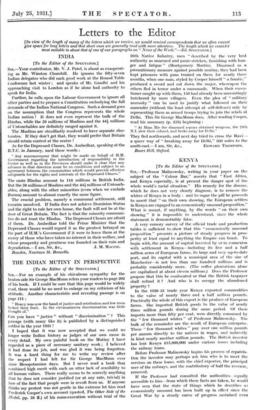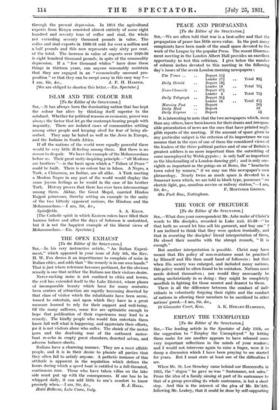KENYA
[To the Editor of the SPECTATOR.] SIR,—Professor Malinowsky, writing in your paper on the subject of the " Colour Bar," asserts that " East Africa, and Kenya especially, is at present the danger spot of the whole world's racial situation." His remedy for the disease, which he does not very clearly diagnose, is to remove the whites of Kenya in a body : and to sugar the pill he proceeds to assert that " on their own showing, the European settlers in Kenya arc engaged in an economically unsound proposition." What is meant, if anything, by the words " on their own showing " it is impossible to understand, since the whole statement is demonstrably false.
A very cursory survey of the official trade and production tables is sufficient to show that this "economically unsound proposition " presents a picture of steady progress in pros- perity at least equal to anything the Empire can boast. To begin with, the amount of capital invested by or in connexion with settlement in Kenya—including its five and a half million acres of European farms, its large and very u p-to-date port, and its capital with a municipal area of the size of Manchester—is not less than one hundred millions and is probably considerably more. (The coffee plantations alone are capitalized at about eleven millions.) Does the Professor propose that this be confiscated or that the British taxpayer shall refund it ? And who is to occupy the abandoned property ?
In the 1930-31 trade year Kenya exported commodities to the value of nearly three and a half million pounds. Practically the whole of this export is the produce of European farms. She imported British goods to the value of nearly three million pounds during the same period. Of these imports more than fifty per cent. were directly consumed by the " few thousand whites " of Professor Malinowsky. The bulk of the remainder are the result of European enterprise. These " few thousand whites " pay over one million pounds per annum directly to the natives in wages, and indirectly in kind nearly another million pounds. The British investor has lent Kenya £15,000,000 under various issues including the railway loans.
Before Professor Malinowsky begins his process of repatria- tion the investor may perhaps ask him who is to meet the services on these loans, with the chief exporter, the principal user of the railways, and the contributory of half the revenue, removed.
If the Professor had consulted the authorities—equally accessible to him—from which these facts are taken, he would have seen that the state of things which he describes as economically unsound has been built up in effect since the Great War by a steady curve of progress sustained even
through the present depression. In 1914 the agricultural exports from Kenya consisted almost entirely of some eight hundred and seventy tons of coffee and sisal, the whole not exceeding seventy thousand pounds in value. The coffee and sisal exports in 1930-31 sold for over a million and a half pounds and this now represents only sixty per cent. of the total. The increase in value of exports over 1929-30 is eight hundred thousand pounds, in spite of the commodity depression. If a " few thousand whites " have done these things in thirteen years, can anyone reasonably maintain that they are engaged in an " economically unsound pro- position " or that they can be swept away in this easy way ?- I [We are obliged to shorten this letter.—En. Spectator.]











































 Previous page
Previous page